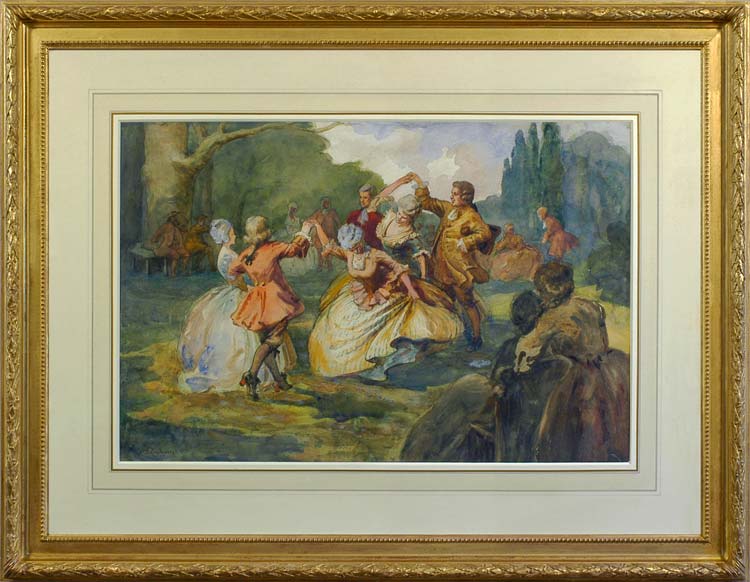Ludovici mentions this work (or possibly the oil painting for which this may be a study) in his memoirs, An Artist’s Life in London and Paris, 1870-1925, London 1926, p.70: ‘In 1878 I was elected a member of the Society of British Artists. A picture I had just completed of Mr Coulon’s dancing class had been seen by several members of that Society, who informed me that if I would exhibit the picture they would make me a member. This picture and its companion, Signor Cruvelli’s singing class, were afterwards reproduced… by etching… The dancing class was well noticed in the papers, and was, I may say, a success.’ Ludovici’s father, Albert senior (1820-94), also produced a number of similar costume pictures, set in 18th century ballrooms and drawing-rooms. A related work by Ludovici junior is Jousting on the river of 1884, a highly-finished oil painting of a couple in 18th century dress. Monsieur Coulon’s dancing class is a more spontaneous study, its pastoral setting sketchily suggested, the focus being on the complex, Watteau-esque group of interwoven dancers. A contemporary note is struck by the foreground spectators, cut off by the borders in the manner of Degas and Caillebotte.
Biographical details
Albert Ludovici (1852-1932) was born in Prague of Bolognese origins, although the family seems to have lived in England from his babyhood. He studied at the Académie Charles and the Ecole des Beaux Arts in Paris, where he was taught by Cabanel, Gérôme and Pils and his fellow pupils included Gervex, Forain and Bastien Lepage. He left Paris when the Prussians invaded, helping his father with the decorative painting of interiors which was his main source of income, but returned to Paris after the war to live by painting portraits. After his marriage in 1875 he settled in England and taught art – in a revolutionary step, to female pupils.
In 1878 Ludovici joined the Society of British Artists, for which his father acted as Treasurer, and when Whistler was elected President of the Society (1886-8) Ludovici served on the committee. In 1886 Whistler took The Times to task for ignoring one of Ludovici’s paintings on exhibition in the SBA. Having been previously attracted by French naturalism and Impressionism, Ludovici was increasingly drawn to Whistler’s work; when the latter was elected President of the International Society, Ludovici became the Society’s delegate in France, so that the two men worked closely together, Whistler calling Albert, ‘My trusty Aide de Camp!’ Ludovici was able to secure Manet’s Execution of the Emperor Maximilian (National Gallery) for exhibition in London, in its whole state, before it was cut up by the dealer Durand-Ruel. He and Whistler remained firm friends and in 1899 visited Holland together with some of Ludovici’s pupils.
Ludovici’s London scenes were greatly influenced by Whistler’s use of tone and colour; however, a contemporary critic remarked that Ludovici’s work sprang on ‘a lighter, gayer stem, that of his own artistic individuality’. He developed a visual shorthand in order to record these scenes en plein air; his first exhibition of this type of work, Dots, notes, spots, was held at the Dowdeswell Galleries, London, in 1888, and was favourably reviewed by George Bernard Shaw. He was a prolific artist; he exhibited at the Royal Academy from 1880, the Royal Society of British Artists from 1881, the Paris Salon from 1884, the New English Art Club from 1891, as well as the Grosvenor Gallery, the New Watercolour Society and the Société Internationale de la Peinture à l’Eau.
Works in public collections include Adieu (Kirklees Museums & Galleries).
See the on-line Correspondence of James McNeill Whistler, University of Glasgow, at http://www.whistler.arts.gla.ac.uk/correspondence/people/ ; Albert Ludovici, ‘The Whistlerian Dynasty at Suffolk Street’, Art Journal, July & Aug. 1906; Albert Ludovici, An Artist’s Life in London and Paris, 1870-1925, London 1926.


